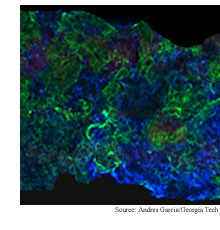
 |
 |
 |
 |
Artificial
bone gets natural gradually
 Coat
a porous material with a gene-delivering virus in decreasing amounts from
one end to the other and you can grow artificial bone that gradually transitions
to ligament rather than ending abruptly.
Coat
a porous material with a gene-delivering virus in decreasing amounts from
one end to the other and you can grow artificial bone that gradually transitions
to ligament rather than ending abruptly. The technique involves seeding a three-dimensional scaffold in decreasing concentrations with a retrovirus carrying a gene that triggers bone cell formation. Cells that fill the scaffold turn to bone where the concentration is high and ligament where it's low, resulting in a more natural transition between bone and soft tissue.
The resulting material could be used in replacement surgery to repair bone and ligament damage.
Research paper:
Engineering Graded Tissue Interfaces
Proceedings of the National Academy of Sciences, August 26, 2008
Researchers' homepages:
Cellular and Biosurface Engineering Laboratory, Georgia Institute of Technology
Joseph M. Le Doux
Robert E. Guldberg
Back to TRN September 1/8, 2008
View from the High Ground Q&A
How It Works
RSS Feeds:
News
Ad links: Clear History
Buy an ad link
© Copyright Technology Research News 2000-2010. All rights reserved.